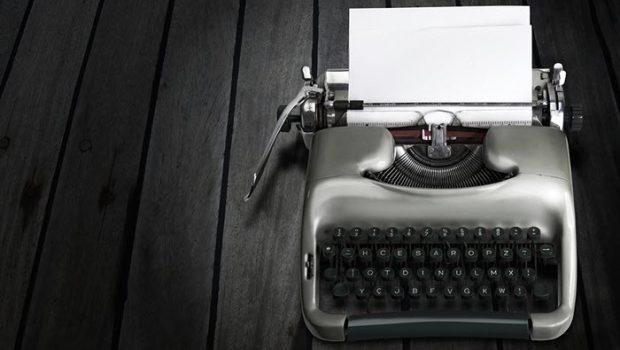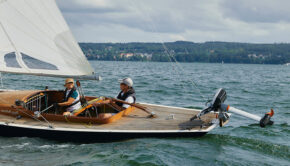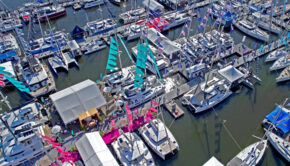A New Ending for End-Of-Use
Published on April 2nd, 2019
Millions of boats that were built in the 70’s and 80’s from virtually indestructible GRP (fiberglass) are now referred to as ‘end-of-use’ boats. Committing redundant GRP hulls to landfill is not an environmentally acceptable option, as they will still be there in hundreds of years’ time.
The challenge is to create a new sub-sector which can responsibly dispose of them. This METSTRADE report looks at how France, USA and Norway are working on a solution by disposing boats the same way as the automotive industry have done for end-of-life cars.
Ambitious plans for boat disposal in France
APER, a non-profit organisation established in 2009 by the French Nautical Industries Federation, has established the first boat dismantling network in Europe. However, only 1 in 10 quotes were being accepted as owners were understandably reluctant to pay for something they would no longer enjoy.
That’s why as of this year, the APER network will become an industry funded ‘Eco-Organisation’, giving boat owners the chance to have their vessel disposed of for free, providing they can get it to one of the dedicated centres at their own cost.
Project manager Ivana Lazarevic told us that they expect to responsibly dispose of 1800 boats this year, with an overall target of 20,000 to 25,000 boats handled in the coming five years via a network of 20 to 30 approved centres.
Regarding the challenges of GRP recycling, Ivana admits that there is work to do, but points out that around 200,000 tons of fibreglass are used for construction purposes every year in France of which only around 5% is used in boats. She therefore believes that working with other industries who have the same end-of-life considerations will provide the solutions.
Positive progress in USA
Evan Ridley, from Rhode Island Marine Trades Association, is managing the company’s Fibreglass Vessel Recycling Pilot Project. With operational donations from major players in the leisure marine market such as 11th Hour Racing, BoatUS and Brunswick Manufacturing, they are now in the process of collecting 20 tons of fibreglass material from end-of-use boats. This will be used in an extended ‘cement kiln trial’ carried out in conjunction with the industrial waste specialists Geocycle, and the cement manufacturer LafargeHolcim.
Geocycle applies the proven technology of ‘co-processing’ by utilising existing facilities in the cement manufacturing industry to resolve waste challenges in a sustainable way. Through high temperatures, oxygen excess and long residence time in the process, the cement kiln completely destroys composite waste materials. As a result, it leaves no residue that needs to be landfilled, as the ash reacts with other components to form the manufactured final product.
Evan and his team expect to be able to start sharing the outcomes of their trial by mid-year, including financial and best practice management data. They are hopeful that other States in the US will be able to replicate their model, and begin the volume processing of waste GRP composites from end-of-use boats via the cement industry route.
GRP recycling, a reality in Norway
Pål Hernes, a business consultant working with the environment agency in Norway, sees a positive progress in Scandinavia on end-of-use boats.
With backing from the Norwegian government, a company called Ecofiber Recycling found ways to break down the redundant GRP composite and turn it into new reusable materials.
Their GRP conversion process produces a number of quality graded, reconstituted granules or individual fibres, these have all been independently tested and certified for their suitability to be used in new production processes.
For instance, one of the substances is being used in the production of a 14 ft (4.2 metre) dinghy, where the inner floor is recycled material, together with most of the stern, seats, and gunwale, basically most of the upper part. This has been found to add stiffness to the hull, and to provide an ideal substrate for mounting equipment with screws, all at a competitive material cost.
Another important development in Norway, has been the decision by the Environment Agency to provide a payment of 1000 Norwegian Kroner (about 100 euros) to the person who delivers the end-of-use boat to the disposal centre. This ‘grant’ is also available for smaller boats up to 5 metres, which can be delivered to a domestic waste disposal site, where normal household waste is usually taken.
The common theme in these success stories
In every case there is funding provided, and the cost to the last owner of the boat is removed from the equation. Combined with even more technical innovation and strategic thinking, this is surely the way forward for a long-standing problem that our industry really has to get to grips with.
Previous METSTRADE articles about end-of-life boats for further reading:
• https://www.metstrade.com/news/articles/can-plastic-boats-be-recycled/
• https://www.metstrade.com/news/articles/end-of-life-boats-reuse-of-grp-latest-news/
• https://www.metstrade.com/news/articles/revyta-new-life-for-boat-industry-composites/









 We’ll keep your information safe.
We’ll keep your information safe.